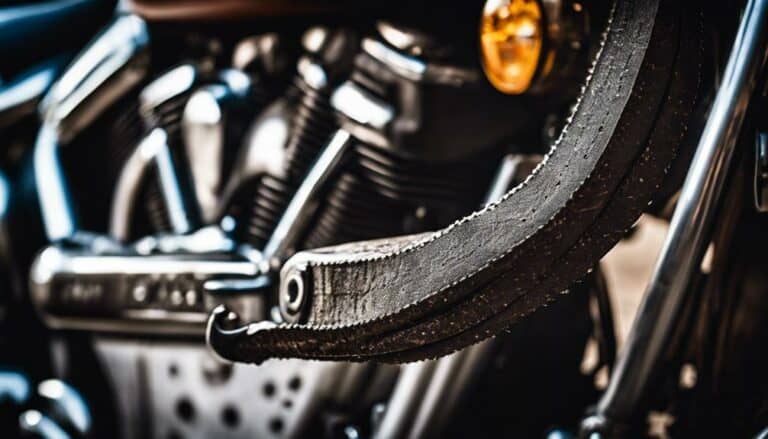When it comes to the longevity of your Harley-Davidson drive belt, the old saying goes, 'An ounce of prevention is worth a pound of cure.'
But how long can you truly expect your drive belt to hold up under normal riding conditions? The answer lies in understanding the key factors that impact its lifespan and the crucial signs to watch out for.
Let's explore the intricacies of drive belt durability and discover practical tips to ensure smooth rides for miles to come.
Key Takeaways
- Proper tension and regular maintenance can significantly extend a Harley Davidson drive belt's lifespan.
- Signs of wear like cracks or unusual noises indicate the need for immediate replacement.
- Timely inspections every 5,000 miles help catch issues early and prevent further damage.
- Professional services for inspection, adjustment, and pulley alignment optimize longevity and performance.
Factors Affecting Drive Belt Lifespan
Improper adjustment significantly reduces the lifespan of Harley Davidson drive belts and increases the risk of premature wear and tear. Belt tension plays a crucial role in ensuring the longevity of the drive belt on your Harley-Davidson motorcycle. Incorrect tension can lead to slippage, overheating, and accelerated wear. To maintain optimal performance and extend the life of your drive belt, it's essential to adhere to the manufacturer's recommended tension specifications.
Regularly inspecting the drive belt for signs of wear is vital in preventing unexpected failures. Road debris and aggressive riding styles can cause damage to the belt, compromising its integrity. Additionally, poorly maintained belt pulleys can exacerbate wear and significantly impact the overall lifespan of the drive belt. During routine service intervals, it's imperative to check for missing teeth, cracks, or any other abnormalities that could indicate potential issues with the drive belt. By staying vigilant and addressing these factors affecting drive belt lifespan, you can ensure a smoother and more liberating riding experience.
Signs of Drive Belt Wear
Inspecting your Harley Davidson drive belt for specific indicators is crucial to identifying potential wear and ensuring optimal performance. Signs of drive belt wear on your Harley Davidson can manifest in various ways. Look out for cracks, fraying, missing chunks, or visible damage on the belt itself. Unusual noises like squeaking or chirping during operation may also indicate belt wear. Excessive belt dust or debris buildup around the pulleys is another sign to watch for. Changes in belt tension, such as slack or tightness, can signal drive belt wear as well.
To maintain the longevity of your drive belt and prevent unexpected breakdowns, it's essential to address any visible signs of wear or damage promptly. Regular inspections and awareness of these signs can help you catch potential issues early on and take appropriate measures to address them before they escalate. Keep an eye out for these signs to ensure your Harley Davidson drive belt stays in optimal condition.
Maintenance Tips for Prolonging Drive Belt Life
For optimal performance and extended lifespan of your Harley Davidson drive belt, regularly checking and adjusting the belt tension is crucial. A recommended inspection every 5,000 miles allows you to monitor the belt's condition closely. Signs of wear such as cracks or missing chunks indicate an immediate need for replacement to prevent further damage.
Ensuring proper tension is essential; improper tension can lead to premature wear and reduced efficiency. Cleaning the belt regularly helps remove debris and contaminants that can cause abrasions and damage over time. Additionally, replacing swingarm bushings can significantly improve overall belt performance and longevity.
When to Replace Your Drive Belt
Replacing your Harley-Davidson drive belt becomes necessary when it exhibits signs of wear like cracks, missing chunks, or significant damage. Regularly inspect the drive belt every 5,000 miles to catch these signs early. If you notice any of these issues, it's crucial to replace the belt promptly to prevent further damage and potential breakdowns on the road.
Additionally, ensuring proper belt tension is essential for optimal performance and longevity. Incorrect tension can lead to premature wear and tear on the belt, affecting its lifespan. If you have upgraded your bike with performance enhancements, consider upgrading to a stronger belt to match the increased power and torque demands.
Professional Inspection and Adjustment Services
To ensure peak performance and longevity of your Harley-Davidson drive belt, scheduling professional inspection and adjustment services every 5,000 miles is highly recommended. When you invest in professional inspection services, you benefit from expert analysis and adjustments that can significantly impact the lifespan of your drive belt.
Here are key aspects of these services:
- Regular Inspections: Qualified technicians can spot wear signs such as cracks or missing chunks, addressing them promptly.
- Belt Tension Checks: Proper tension adjustments are vital for longevity and preventing premature failures.
- Pulley Alignment: Professional assessment of pulley alignment ensures smooth power transfer and reduces the risk of damage.
- Overall Belt Condition: Technicians evaluate the belt's overall condition to catch potential issues early.
- Maximize Lifespan: Investing in these services can optimize the lifespan of your drive belt, saving you from costly repairs down the road.
Conclusion
In conclusion, ensuring the longevity of your Harley-Davidson drive belt requires regular inspections, maintenance, and timely replacements. Factors such as proper tension, signs of wear, and upgrading to a stronger belt are crucial for optimal performance.
By staying proactive and addressing any issues promptly, you can avoid costly repairs and potential breakdowns on the road. Remember, a well-maintained drive belt is essential for a smooth and safe riding experience.

